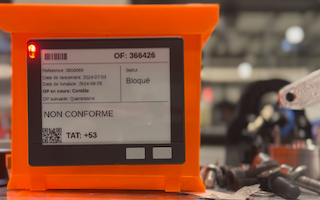What are the differences between RTLS and RFID?

What is RFID?
RFID (Radio Frequency Identification) uses radio frequency (RF) electromagnetic fields to automatically identify and detect tags in close proximity to a reader. The tags contain electronically stored information, which can be read from a distance by an RFID reader.
This proximity detection is done using a powerful RFID reader (fixed or mobile) that transmits power to a passive RFID tag on the asset so that the tag sends back its ID to the reader. Therefore, it is used to detect that an asset has been at a specific location at a given time but it cannot be used to locate the asset in real-time continuously. RFID technology is similar to barcoding in that it captures data from tags or labels using a device that stores the data in a database. In that sense, RFID is typically used for tracking and identifying objects that do not need to be continuously tracked in real time. It is used in a variety of applications, including supply chain management, animal tracking, and access control.

What is RTLS ?
RTLS (Real Time Location System), as its name suggests, is a solution that enables to track the location of a physical asset or a person in real time, using RF (Radio-Frequencies) or GPS/GNSS technologies depending on the type of environment (indoor/outdoor).
The RF technologies most commonly used for RTLS are Wi-Fi, BLE (Bluetooth Low Energy), UWB (Ultra WideBand) and Ultrasound. They all require active tags that are powered by batteries in order to be able to broadcast a signal at a regular interval to fixed antennas, called “anchors”.
RTLS Anchors are battery-powered or cabled. They receive the signal from the tags to then send it back to the software on a server where positioning algorithms calculate the exact position of the RTLS Tag in real-time and publish it on a map.
RTLS systems typically use a combination of hardware (e.g. tags, anchors and gateways) and software to provide real-time location information for objects. RTLS is often used in applications where it is important to know the exact location of an object at all times, such as in a hospital or manufacturing facility.

Major differences between RFID and RTLS:
RFID and RTLS are used for different use cases and sometime they can complement one another:
- Data delivery method
RFID tags store data that can be read by RFID readers, whereas RTLS systems use active tags that transmit data to receivers in real-time. This means that RFID systems can only provide location data when the tags are within range of the readers, whereas RTLS systems can provide location data in real-time as long as the active tags are within range of the receivers.
- Range
RFID tags can be read from a distance of a few inches to several feet, depending on the frequency and the type of tag. RTLS systems, on the other hand, can track objects over a much larger range, typically up to several hundred meters. Also, the price of RTLS Anchors is much less than the price of RFID Readers, and some RTLS Anchors can be wireless. This means that it is much less costly and complex to install multiple RTLS Anchors within a site compared to installing multiple RFID Readers.
- Accuracy
RFID systems can provide accurate location data for objects only when they are within their range, but the accuracy of the data decreases as the distance between the tag and the reader increases; RFID is very sensitive to metal. RTLS systems can provide more accurate location data in real-time, as they use active tags that transmit their location continuously. For example, using Ultra-WideBand, the accuracy of the location can be between 0.2-0.3m even in very metallic environments like factories.
- Purpose
RFID technology is to be used when it is needed to only detect that an asset has been entering or exiting a specific zone, or for doing inventory using a mobile RFID reader.
RTLS is to be used when it is needed to get a frequent position of the asset wherever the asset is on site.
RFID typical Use Cases:
Whilst they are many different use cases for RFID, here is a selection of the most typical ones:
- Highway toll collection
RFID technology is often used in highway toll collection systems, as it allows vehicles to pass through toll booths without stopping to pay. - Retail inventory management
To improve the accuracy and efficiency of retail inventory management by enabling retailers to quickly scan and track the movement of products. - Quality control in manufacturing:
To monitor the production of goods and ensure that materials and formulas are being used correctly. RFID tags can also be used to report data at critical stages of the production process, which can be helpful in identifying and fixing any issues that may arise.
- Access control
To control access to buildings, events, or other areas by using RFID-enabled badges or cards. - Supply chain management
To track the movement of goods through global supply chains and ensure that products are delivered to the right place at the right time.

RTLS typical Use Cases
Real-time location systems (RTLS) are used in a variety of different industries and applications. Some typical use cases for RTLS include:
For real-time and transparent visibility on production operations with automatic alerts for detected delays.
To measure their utilisation rates based on their movement data. One can also receive automatic alerts in case a tool exits a specific zone or if it doesn't move for a long time.
To prevent accidents from happening on your site by alerting in real-time workers of nearby hazards. Also, by tracking workers, one can make sure all staff is safe when an emergency occurs.
To reduce time spent searching for them, mutualize their utilisation and avoid losing them.
To follow patients during their treatment process in order to organise resources accordingly, reduce waiting times and update automatically the discharge time.
- Inventory management
To track and manage inventory in real-time, helping businesses to stay on top of their stock levels and ensure that they have the products they need where and when they need them.

Sometimes a combination of RFID detection and RTLS location tracking can be interesting when objects that need to be tracked can only be moved by vehicles such as forklifts. Indeed, in this case, an RFID Reader can be placed on the vehicle and a passive RFID tag can be placed on the object in order to detect what asset has been picked up and dropped by the vehicle. Then, adding a RTLS tag on the vehicle enables to get the real-time location of the vehicle at the exact moment when it is picking up or dropping the object. This way, one can associate the RFID detection of the object with the location of the vehicle to determine where the object has been picked up and where it has been dropped. As the objects can only be moved by the vehicles, the system will always provide the correct location information of the objects even if they are not equipped with active (and more expensive) RTLS tags.
Here you can find a video of a prototype Ubudu developed combining RFID and RTLS technology for automatic and localised inventory: https://www.youtube.com/watch?v=sJBBAyEah6Y
To sum up:
RFID main advantage:
- The fact that the RFID tags are passive means that they are much less costly, they don’t require any battery maintenance and can be very thin and small. RFID tags can therefore be used on a lot more different types of assets, even assets that are consumables.
RTLS main advantages:
- RTLS provides safe, reliable, fast and precise results, making it the ideal solution for companies that need continuous tracking of their assets and/or to better manage workers' time and/or to maximise the utilisation of their equipment.
- RTLS technology has more range and does not always require direct line of sight to acquire and transmit location data accurately.
- RTLS solution allows, in addition to locating assets in real-time, to analyse and measure key information related to the flow of operations such as the monitoring of the logistics flow and production flow. This helps identify bottlenecks in workflows to streamline operations.

Asset tracking systems are a must-have for healthcare facilities, and manufacturing sites.
Ubudu offers different technical solutions for RTLS to allow you to reduce time wasted searching for assets, maximise the utilisation of your assets and improve the flow of your operations.
If you have any questions please contact us, our experts will be happy to help.
Related articles:
https://ubudu.com/post/ubudu-rtls-is-being-used-by-paris-saint-joseph-hospital-mobile-apps
https://ubudu.com/post/ubudu-safety-zone-to-help-prevent-worker-accidents-in-dangerous-sites
https://ubudu.com/post/what-benefits-does-rtls-bring-to-the-management-of-medical-equipment
News that might interest you

BLE ESL and RTLS Integration in Manufacturing
Ubudu’s BLE ESL integration with its RTLS delivers real-time asset tracking and automated updates for manufacturing. Featuring dynamic ESL displays from brands like PDI Digital and Minew—with options in size, interchangeable batteries, and shock protection—this solution streamlines workflows using a wireless BLE network, available via SaaS or on-premise.

The power of Hybrid RTLS solutions
Hybrid RTLS combines the benefits of different location tracking technologies to provide the most efficient results for tracking needs and can be used for multiple use cases. As indoor and outdoor positioning become increasingly interconnected, it is important to consider how to combine different RTLS technologies to improve ROI and meet the needs of end-users.

Introduction to Ubudu BLE Controller
Ubudu launches “BLE Controller”, a new feature available in Ubudu RTLS that will enable you to communicate with any RTLS tag remotely, right from your desk.




